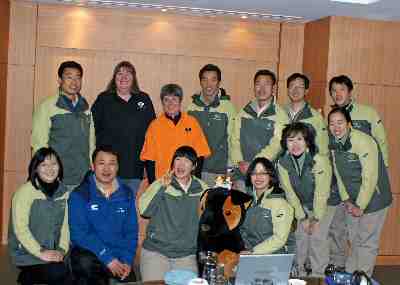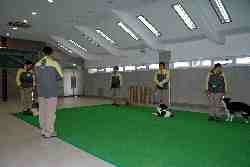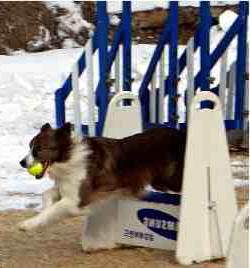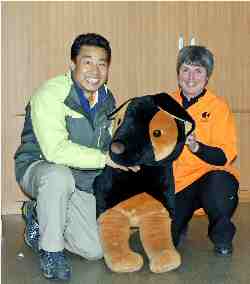Heart and Seoul...
 Chris
Mancini and Val Harvey, both members of the Association of Pet Dog Trainers (APDT) Committee,
are actively involved in delivering Pet Dog Training Instructors
courses to 'wanna be' dog trainers. It was this link that brought them to Samsung in Seoul, South Korea.
They were invited to the Academy to present their dog training instructors course to a team of
novice trainers, but
they were also asked if they could spend two of the days teaching agility as well. There they
found an enthusiastic group of handlers eager to learn more! Chris
Mancini and Val Harvey, both members of the Association of Pet Dog Trainers (APDT) Committee,
are actively involved in delivering Pet Dog Training Instructors
courses to 'wanna be' dog trainers. It was this link that brought them to Samsung in Seoul, South Korea.
They were invited to the Academy to present their dog training instructors course to a team of
novice trainers, but
they were also asked if they could spend two of the days teaching agility as well. There they
found an enthusiastic group of handlers eager to learn more!
Samsung have built a huge
dog training academy
just outside Seoul. Within the Academy, there are several sections including Hearing Dogs,
Guide Dogs for the Blind, Detector Dogs, Search & Rescue Dogs and Therapy Dogs. There is also a Sports
Dog section. One of the main purposes of the academy is to promote dogs and their wonderful
attributes in the country. This is done through displays from all the different sections
including HTM, flyball and agility.
All the dogs live at the
Academy in their respective units with trainers and kennel staff to see to all their needs and
teach them the required discipline. Samsung decided they would like to expand their work to
encompass Pet Dog Training as well. In Seoul, small dogs are more popular than large dogs
primarily because a lot of the housing is apartments. People tend to send their small dogs away
for three months to be trained as really was no other option if they needed help.
Val and I were both nervous and
excited at the prospect of our visit. We had our own pre-conceived ideas of
Korean culture which included the Korea attitude towards dogs – eating them! To our relief, these illusions
were quickly shattered.
 Seoul is a huge bustling
city, very busy extremely clean. People mostly live in flats so we actually saw very few
dogs - just two - during our couple of days in the city. We stayed in a suburb
of Seoul, a half an hour from the city centre and another 45 minutes from the Samsung
Academy. The Academy was close to a huge Disneyland -type theme park called Everland, the third largest in the
world, also owned by Samsung. Seoul is a huge bustling
city, very busy extremely clean. People mostly live in flats so we actually saw very few
dogs - just two - during our couple of days in the city. We stayed in a suburb
of Seoul, a half an hour from the city centre and another 45 minutes from the Samsung
Academy. The Academy was close to a huge Disneyland -type theme park called Everland, the third largest in the
world, also owned by Samsung.
The Academy
Fifteen years ago the then Chairman of Samsung had set the
academy up to help change people's perception of the dog and to demonstrate what a valuable
asset they are. The Sports Dog section included dogs
that part of the agility, flyball and HTM display team. Some of the handlers had competed in
agility and had been over to England to hone their skills. They've had various well known,
celebrity trainers (including Mary Ray) from around the world to coach them in the different disciplines, but
were desperate to learn more and to ensure they were doing it in the best and most
effective way. Keith Warwick from SARDA in the Lake District, for instance, helped set up their Search
&
Rescue section at the Academy, and the trainers visit the different assistance dogs units around the
world to see how they work so they can bring back their ideas and implement them, where
appropriate, in their units.
Pet dog training was
completely new to all of them except Bruce who had some experience and was an ideal pet dog
trainer being, kind calm and patient. He seemed to have a permanent smile for everyone. He is
also their top agility man and had competed successfully in the World Cup and various other
competitions. He is in charge of the Sports Dog section and training all the novice dog
handlers in the skills of agility.
 Training
is cool Training
is cool
Weather in South Korea was
rather chilly –20 C was coldest and it was positively hot on one day at –3 C! For some reason I
assumed agility would be at an indoor venue! Wrong, they cleared a foot of snow from the field
on our first day so they could demonstrate their agility skills! Luckily I always over-prepare
for cold weather!
The first eight days of the
course was for delivering the Pet Dog Training Instructors course. It was soon apparent how
hard working and dedicated our students were. We had a core of 10 students with other
trainers coming in on some sessions. We were slightly concerned because we had been told that in
Korea 'teachers teach and students listen.' We explained that this was not how we worked.
We
needed questions and answer discussions to ensure the students understood what was being said.
We were
also told that the Koreans were quite reserved and would not be so obvious with their body
language so another concern was the language barrier. We had to work through our translator Queenie
who had the mammoth task of not only translating all the
sessions for the course but also trying to keep on top of all the discussions!
 The course finished and
agility days were next The course finished and
agility days were next
Unfortunately the weather was not to be on our side and the forecast
for rain all day on the Wednesday was not wrong. It did not let up all day which stopped us
working outside. The students were really disappointed. For some of them this was what they
had been looking forward to the most. I decided to do an indoor theory session in the morning,
a short presentation and then discussion to find out where everyone was at and the different
challenges facing individuals.
Their problems were pretty much the same as over here - contacts and weaves were
the main ones. We spent some time discussing how we could overcome some of these challenges
with the aid of a table top set of agility to demonstrate and discuss the different exercises.
For the afternoon, we set some time aside for HTM – gulp.
Putting moves to music is not one of my specialities. Following a demonstration of their different routines,
Val and I actually
realised that the students needed more help in motivating the dogs and appropriate use of clicker
training and we were able to drastically improve the dog's attitudes and motivation to complete
the required routines. This was exactly the same as for agility handler who often feel the need to
repeatedly go over the same sequence until the dog gets it right! Rather than taking a step
back and looking at why it is going wrong - and how you could make it easier for the dog to
understand. Repeatedly going over routines with little use of appropriately timed rewards is
completely de-motivating for the dogs. Short, successfully rewarded sequences are much more
likely to keep your dog motivated and build up your relationship with your dog. Within minutes
the dogs were motivated – tails wagging, heads up, gait improved. What a difference!
In the afternoon we brought
in some contact equipment and used it on the floor of the training hall to demonstrate the
different ways we can train the contact, depending upon the dog's preference and approach. Some
decided to use targets, others two on/two off. Those with consistent contacts left well alone!
 The following day the rain
stopped, and we were able to get outside. We set up some short sequences to help improve
their skills. Bruce's ability as an instructor was very evident. He had spent a couple of weeks
in England, staying with an agility trainer to learn as much as possible about the sport, so he
could bring his knowledge back to Korea and set up the Sports Dog section at the Academy. The following day the rain
stopped, and we were able to get outside. We set up some short sequences to help improve
their skills. Bruce's ability as an instructor was very evident. He had spent a couple of weeks
in England, staying with an agility trainer to learn as much as possible about the sport, so he
could bring his knowledge back to Korea and set up the Sports Dog section at the Academy.
All the dogs were
experienced agility dogs apart from two and had been paired with novice handlers who had been
training for three months prior to our visit. Bruce had done a fantastic job with the handlers
in this short time. There were, of course, the usual sort of problems you would expect - the
dogs taking their own line, the handlers getting to grips with using the appropriate body
language and cues to get the best out of their dogs but, the most surprising thing for me, was
the fantastic relationship all the handlers seemed to have with their dogs despite the short
time they had been working together. Maybe this is due to the time that they spend with
the dogs is quality time? A common problem in Britain is we often ask far too much from the dog
with too few rewards or not great enough rewards! This can be very de-motivating for a dog and
can also means often the dog does not fully understand what is required of it. Again, we
were able to get our students to understand very quickly that motivation was the key to
success.
We were limited in the
amounts we could do because of muddy conditions that became slippery towards the afternoon, but
lots of short sequences with appropriately timed, motivating rewards saw an improvement in the
attitude of handler's and dog's.
A wonderful
experience
Though South Korea was an unlikely holiday destination but it
was a fantastic opportunity to visit a country extremely proud of its
culture. The residents bend over backwards to look after
visitors and we made some very special friends and any pre-conceived ideas were quickly
dispelled.
About the author...
 Chris
Mancini is a member of the APTD and runs puppy socialism classes in Enfield. She also does
agility with beardie cresses at Trent Park. Chris
Mancini is a member of the APTD and runs puppy socialism classes in Enfield. She also does
agility with beardie cresses at Trent Park.
|